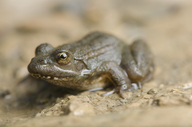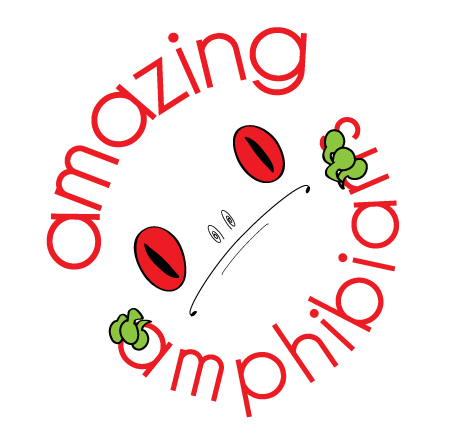|
Pelophylax cerigensis (Beerli, Hotz, Tunner, Heppich & Uzzell, 1994)
Karpathos Frog | family: Ranidae genus: Pelophylax |
 © 2022 David C. Broek (1 of 2) |
|
|
|
Description Pelophylax cerigensis is part of the western Palearctic water frog group, which is differentiated from the Palearctic brown frog group by its extensive foot webbing, males’ external lateral vocal sacs, mottling on inner thighs, and absence of a black face mask. In contrast to the calls of Pelophylax cretensis, the calls of Pelophylax cerigensis do not have amplitude subdivision beyond pulse groups (Beerli et al. 1994). Dorsally, Pelophylax cerigensis is light brown or olive, and may have brown spots. There is no vertebral stripe, and the venter is creamy with mottled gray. The males have gray vocal sacs (Beerli et al. 1994). Distribution and Habitat Country distribution from AmphibiaWeb's database: Greece
Life History, Abundance, Activity, and Special Behaviors Trends and Threats Possible reasons for amphibian decline General habitat alteration and loss Comments The Crete water frogs diverged from other western Palearctic frogs anywhere from five to six million years ago. Karpathos frogs diverged from Anatolian frogs around three million years ago. These dates were obtained through genetic protein electrophoresis data. Pelophylax cerigensis is sister to Pelophylax bedriagae in both genetic (allelic differences at only 2 of 31 loci) and geographic distance (Beerli et al. 1994). The species epithet “cerigensis” comes from Cerigo, which is a Latin name for Karpathos. Pelophylax cerigensis is the only water frog on Karpathos (Beerli et al. 1994). Pelophylax cerigensis was previously named Rana cerigensis (Beerli et al. 1994).
References
Beerli P, Hotz H, Tunner H, Heppich S, and Uzzell T. (1994). ''Two new water frog species from the Aegean islands Crete and Karpathos. (Amphibia, Salientia, Ranidae).'' Notulae Naturae, 470, 1-9. Beerli P, Uzzell T, Lymberakis P. (2009). ''Pelophylax cerigensis.'' The IUCN Red List of Threatened Species http://dx.doi.org/10.2305/IUCN.UK.2009.RLTS.T58567A11787309.en. Downloaded in January 2017 Originally submitted by: Sierra Raby (first posted 2017-02-07) Edited by: Ann T. Chang (2017-09-07) Species Account Citation: AmphibiaWeb 2017 Pelophylax cerigensis: Karpathos Frog <https://amphibiaweb.org/species/5000> University of California, Berkeley, CA, USA. Accessed May 30, 2025.
Feedback or comments about this page.
Citation: AmphibiaWeb. 2025. <https://amphibiaweb.org> University of California, Berkeley, CA, USA. Accessed 30 May 2025. AmphibiaWeb's policy on data use. |



 Map of Life
Map of Life Featured in Amazing Amphibians on 17 June 2013
Featured in Amazing Amphibians on 17 June 2013